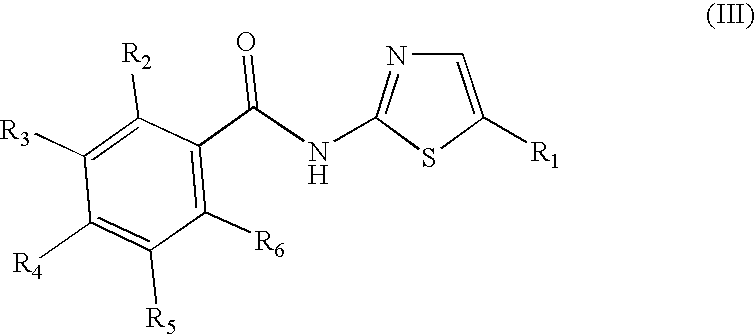Halogenated benzamide derivatives
a technology of benzamide and derivatives, applied in the field of halogenated benzamide derivatives, can solve the problem of lack of activity of bacterial gut microflora when administered orally, and achieve the effect of reducing deleterious effects
- Summary
- Abstract
- Description
- Claims
- Application Information
AI Technical Summary
Benefits of technology
Problems solved by technology
Method used
Image
Examples
example 1
Testing Against Viruses
Methods
Non-Hepatic Viruses
[0055]Cell cultures and Treatments. HEp-2 laryngeal carcinoma cells, monkey kidney 37RC, MA104 and VERO cells, canine Madin-Darby kidney (MDCK) and mammary adenocarcinoma (A72) cells, were grown at 37° C. in a 5% CO2 atmosphere in RPMI medium (Gibco-Invitrogen, Carlsbad, Calif.), supplemented with 10% fetal calf serum (FCS), 2 mM glutamine and antibiotics. Compounds dissolved in DMSO stock solution (50 mg / ml) were diluted in culture medium and added to infected cells immediately after the 1 hour adsorption period. Compounds were maintained in the medium for the duration of the experiment. Controls received equal amounts of DMSO diluent. Each concentration of each compound was tested in duplicate and each experiment was repeated twice.
[0056]Virus infection and titration. The following viruses were utilized: Influenza A: strain Puertorico (PR8); Paramyxovirus (Parainfluenza): Sendai virus (SV); Rhabdovirus: Vesicular Stomatitis Virus (V...
example 2
Testing Against Anaerobic Bacteria
[0065]Methods. Recent clinical anaerobic isolates (2000 to date) comprised 40 B. fragilis group, 26 Prevotella / Porphyromonas, 28 fusobacteria, 16 anaerobic Gram positive cocci, 14 anaerobic Gram-positive non-sporeforming rods and 18 clostridia. CLSI agar dilution MIC methodology with enriched Brucella blood agar and inocula of 1×105 cfu / spot was used. Plates were incubated in an anaerobic glove box at 35° C. for 48 h.
Results. MIC50 / MIC90 values (μg / ml) were as follows:
[0066]
gpPrev / PorphyFusobacteriaGram + cocciGram + rodsClostridiaAllDrug(40)(26)(28)(16)(14)(18)(142)Nitazoxanide2 / 44 / 81 / 40.5 / 2 16 / >320.5 / 4 2 / 4Tizoxanide2 / 4 2 / 160.5 / 2 0.5 / 1 8 / >320.25 / 2 2 / 4RM 4803>32 / >32>32 / >32>32 / >32>32 / >32>32 / >32>32 / >32>32 / >32RM 4819>32 / >32>32 / >32>32 / >32>32 / >32>32 / >32>32 / >32>32 / >32Amoxicillin-1 / 40.06 / 0.5 0.5 / 4 0.125 / 0.5 0.25 / 1.0 0.125 / 1.0 0.5 / 2.0clavulanicacidClindamycin 2 / >32≦0.015 / ≦0.015 0.06 / 0.1250.125 / 0.5 0.125 / 4 1 / >320.125 / 8.0 Metronidazole1 / 20.5...
example 3
Antiviral Activity
[0068]Compounds within Formula (IV) of the present invention exhibit potent antiviral activity, as shown in Table 5.
[0069]EC50 (μg / mL) values for 2-(acetolyloxy)-3-methyl-N-(5-bromo-2-thiazolyl)benzamide (RM4803), 2-(acetolyloxy)-3-methyl-N-(5-chloro-2-thiazolyl)benzamide (RM4804), and 2-(acetolyloxy)-3-methoxy-N-(5-bromo-2-thiazolyl)benzamide (RM4806), on Human Rhinovirus Type 39 (HRV-39), and H3N2 influenza virus, type A, using a multiple cycle CPE inhibition assay on OH-I Hela and Madin Darby Canine Kidney (MDCK) cell monolayers, respectively, were measured by microscopic and spectrophotometric methods. Pirodavir and Oseltamivir were included as positive controls.
[0070]
TABLE 5Activity of RM-4803, RM-4804 and RM-4806 againstviruses in cell monolayerHuman Rhinovirus Type39Influenza A VirusOH-HelaMDCK2% McCoys + Hepes0% EMEM +BufferHepes + TrypsinMicroscopicMicroscopicCompoundSpectrophotometerSpectrophotometerR1 = Br0.060.030.450.18R4 = methylR3 = methyl(RM 4803)R1...
PUM
| Property | Measurement | Unit |
|---|---|---|
| wavelengths | aaaaa | aaaaa |
| wavelengths | aaaaa | aaaaa |
| concentrations | aaaaa | aaaaa |
Abstract
Description
Claims
Application Information
 Login to View More
Login to View More - R&D
- Intellectual Property
- Life Sciences
- Materials
- Tech Scout
- Unparalleled Data Quality
- Higher Quality Content
- 60% Fewer Hallucinations
Browse by: Latest US Patents, China's latest patents, Technical Efficacy Thesaurus, Application Domain, Technology Topic, Popular Technical Reports.
© 2025 PatSnap. All rights reserved.Legal|Privacy policy|Modern Slavery Act Transparency Statement|Sitemap|About US| Contact US: help@patsnap.com



